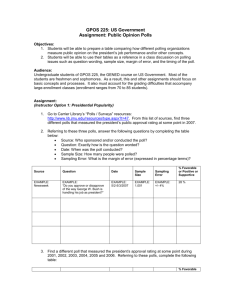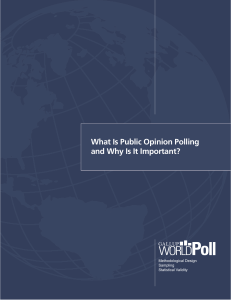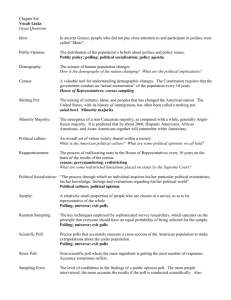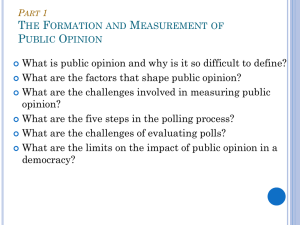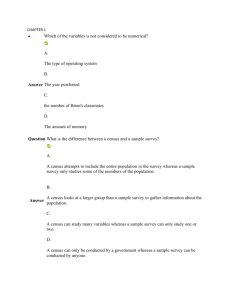Political Science 30: Political Inquiry
advertisement
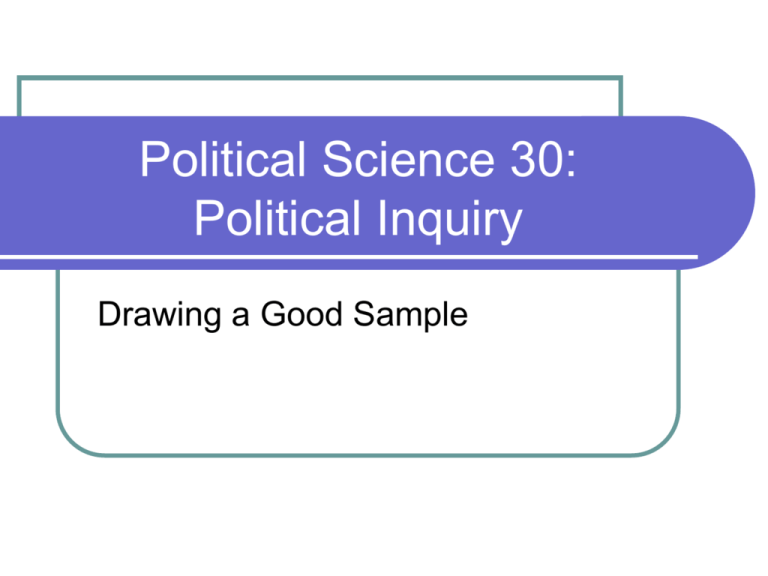
Political Science 30: Political Inquiry Drawing a Good Sample Finishing Up Polling Random Sampling Margin of Error Nonrandom methods of drawing a sample or HOW NOT TO DO A POLL Convenience sample Voluntary response sample How to Draw a Random Sample A simple random sample gives all members of the population an equal chance to be drawn into the sample. Draw names out of a hat, a really big hat Label every case in the population with a number, then draw some random numbers In a telephone poll, random digit dialing uses a random number generator to get even those with unlisted numbers. How to Draw a Random Sample WARNING! Random sampling and random assignment are different! Random sampling selects which cases in your population you will study. Random assignment starts with a sample, then divides it into two or more groups. Observational studies may use random sampling, but not random assignment, and this hurts their internal validity. How to Draw a Random Sample Sampling bias is consistent deviation of the sample statistic from the parameter Sampling variability describes how far apart statistics are over many samples. What Determines the “Margin of Error” of a Poll? If we have drawn a truly random sample: pˆ p RandomErro r Sample Proportion = Population Proportion + Random Error What Determines the “Margin of Error” of a Poll? The margin of error is calculated by: pˆ 2 ( pˆ )(1 pˆ ) N What Determines the “Margin of Error” of a Poll? In a poll of 505 likely voters, the Field Poll found 55% support for the recall. 0.55 2 (0.55)(1 0.55) 505 0.55 0.044 What Determines the “Margin of Error” of a Poll? The margin of error for this poll was plus or minus 4.4 percentage points. This means that if we took many samples using the Field Poll’s methods, 95% of the samples would yield a statistic within plus or minus 4.4 percentage points of the true population parameter. Nonrandom methods of drawing a sample (Note: These are Bad!) A voluntary response sample includes the members of the population who voice their desire to be included in the sample. 1936 “Literary Digest Poll” mailed 10 million ballots to magazine readers to volunteer participate in their Presidential election survey. 2 million surveys came back, predicting that FDR would lose 43%-57%. FDR won, 61%-39%. Nonrandom methods of drawing a sample (Note: These are Bad!) A convenience sample studies the segment of the population that is easiest for the researcher to reach. Polls only of people who have telephones. (Less of a problem than it used to be). Studies by college students of their dormmates. Internet polls at www.foxnews.com or www.sierraclub.org Example: Internet Polls Some internet polls ask More professional the opinions of those internet polls who have logged on to: advertise with banners on a variety www.foxnews.com of web sites to www.uclabruins.com recruit people into www.peetscoffee.com their sample. www.pabst.com www.sfgate.com www.rogaine.com Example: Internet Polls “Knowledge Networks” is an internetadministered survey that recruited its sample by using random digit dialing. To give those without an internet connection the chance to participate, they offered a free “Web TV” console to participants. Those in the 50,000 person sample are given the chance to participate in polls about subjects like hard liquor or politics. Surveys of a Sub-Population Many researchers do not want to generalize to the population of “all Americans.” They begin by defining the population that they want to study, such as “likely voters,” “Asian-Americans voters,” or “Lesbian, Gay, Bisexual, and Transgendered California adults.” Surveys of a Sub-Population Option #1. Take a random sample of the entire population, ask the respondent if he or she fits into the category, and then continue the interview if you find a match Option #2. Begin with a list that approximates the entire subpopulation (registered voters with Asian surnames) and then take a random sample.

